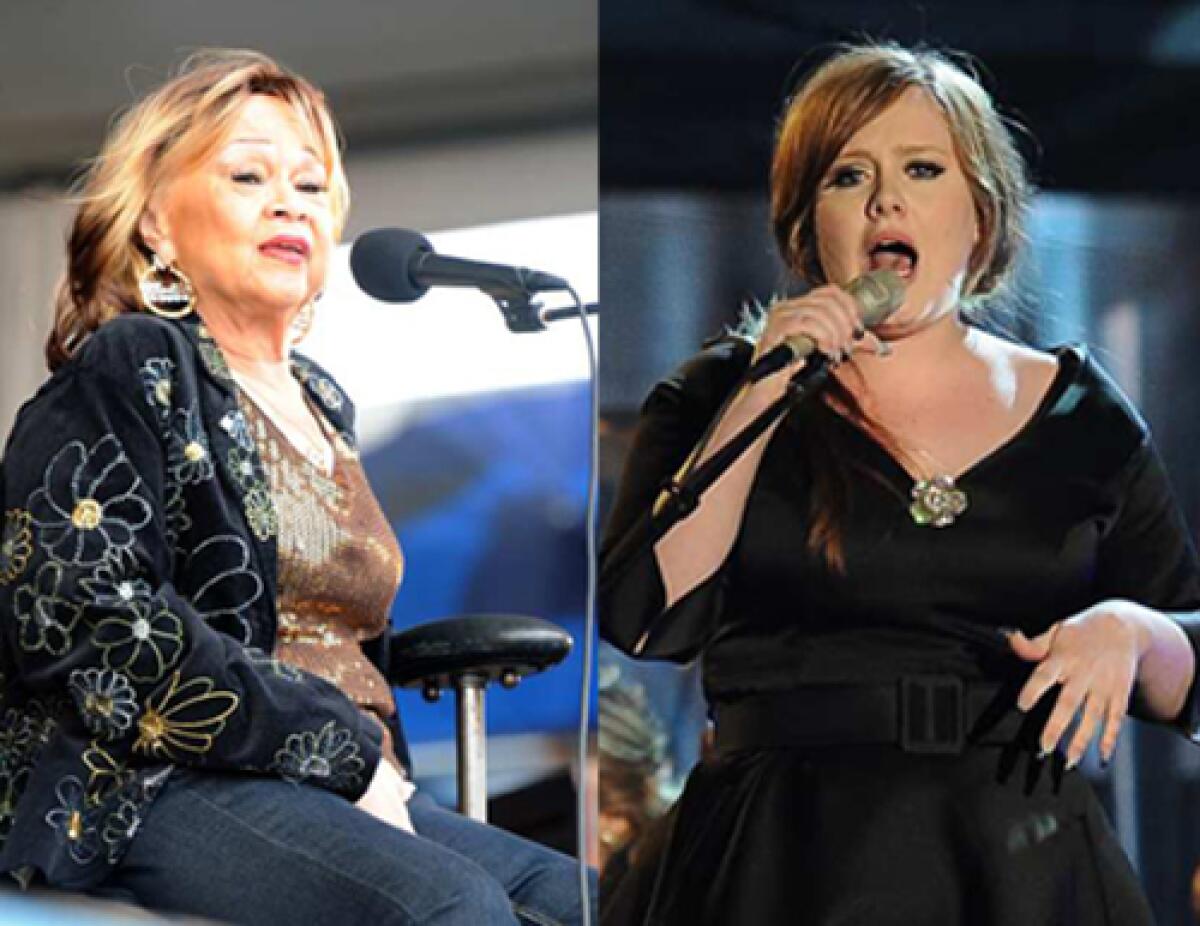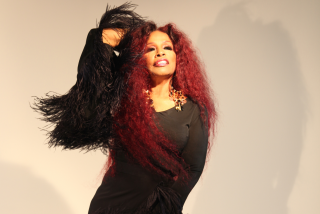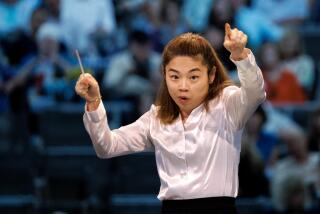A Hollywood mixing Bowl

Adele can’t contain herself. Nothing new there. The hot young British soul singer is, by her own account, “pretty mouthy.” But learning that she will share the bill with her idol, Etta James, at the Hollywood Bowl next Sunday has sent her over the moon.
“It blew my mind,” she gushes on the phone from London. “She’s the reason I started. The first time I heard her voice, it sucked me in. Made me believe, and made me cry.”
James will join Adele thanks to the Bowl’s one-up, one-off style of “creative packaging” -- an ambitious, arduous, occasionally nerve-racking attempt to put on shows that go beyond the usual summer fare.
“It’s a constant balancing act,” says Arvind Manocha, chief operating officer of the Los Angeles Philharmonic Assn., which oversees the Bowl’s programming. “Can we find the right pairings? Can we help an artist do something differently? We want concerts that only exist at the Bowl.”
That can mean uniting two performers who otherwise might not work together. “Here’s a new British artist who loves a legend that we’ve got a long history with,” says Manocha. “We can make it happen for them.”
It also means embracing what senior programming manager Johanna Rees calls “our synergistic philosophy -- you know, one plus one equals five,” in which genres and generations cross over in hopes of sparking some creative combustion, and big names help new or niche acts fill the 17,000 seats.
Rees already had booked flamboyant, frenetic indie popsters Of Montreal when she heard that eternally flamboyant, chic Grace Jones (who’s been emerging from a decades-long hiatus) might be coming to America. To complement this July 26 double bill, she’s added Dengue Fever, an L.A.-based hybrid band fronted by Cambodian pop singer Chhom Nimol. “What we always hope for when we put these shows together is a special moment,” says Rees. “Artists inspiring each other. Or maybe an artist inspired to do what they don’t usually do.”
In recent seasons, the Bowl has been pairing the Philharmonic with indie bands. The latest is Death Cab for Cutie, which will arrive July 5 for an evening that includes two Canadian outfits: Tegan and Sara, and the New Pornographers. “Playing at the Hollywood Bowl is an event in itself,” says Death Cab’s leader, Ben Gibbard. “Being on tour, you’re doing the same stuff every night. But you expect a kind of magic to happen in a place like that.”
Gibbard adds that he’s “a bit intimidated by playing with the Philharmonic.” However, he says, “we’ve got the chance to show what we’re made of. We’re excited to meet them. We hope they feel the same.”
Over the years, even old pros such as James Brown have been persuaded to try something new. In 2006, a few months before he died, Brown agreed to perform music he hadn’t sung since he recorded his 1970 jazz/big-band album, “Soul on Top.” “Many times, he was quoted about wanting to go back to that chapter in his musical life,” says Manocha. “But he never did. So we made an offer: ‘We’ll hire the big-band musicians. We’ll make the charts.’ ”
Watching the 73-year-old Brown rehearse was memorable, says Laura Connelly, the Philharmonic’s director of presentations. “He sang these songs as if they had never left him, with such emotion and clarity. He was thrilled to be back with his jazz roots.”
The next day, however, things changed. “James Brown has this persona,” says Connelly. “Once he went on, that persona took over. It was a really good show, but not quite as good as the rehearsal. I think he lost his nerve a little. Being onstage took him out of what he’d been doing.”
Such surprises aren’t that surprising to the Phil’s bookers, who list “being prepared for anything” and patience among lessons learned after years of adventures in programming.
Performers may need reassurance about working outside their comfort zones. Music may need to be created, or re-created, on short notice. Producing any event at the Bowl involves a scramble to get everything together in time for the rehearsal -- often, there’s only one -- at which conductor, artists and technical staff may be seeing and hearing one another for the first time. (Mixing sound outdoors for a rock band and an orchestra of a hundred is an art in itself.)
From concept to concert
Every booking cycle begins with a flurry of ideas. Connelly, who specializes in jazz and world music, and Rees, who handles pop and rock, brainstorm with the Philharmonic’s other programmers and with colleagues including Christian McBride, the creative chair for jazz. They also travel the concert circuit, roam the Internet and network with agents, artists and bookers.
World music is one of the Bowl’s strengths -- in part because Connelly and Rees say they try to present “even the traditional in a nontraditional way.” After a Bollywood night featuring A.R. Rahman three years ago, the Bowl is lining up a Sept. 20 show that includes classical and folk programs curated by Ravi Shankar, the folk-Sufi-rock-funk sound of the band Kailash Kher’s Kailasa and Punjabi pop from Malkit Singh.
Like other major orchestras, the Philharmonic uses the summer to reach out to audiences who may not flock to the concert hall in the fall. “There’s a long history of working with pops, jazz and rock,” says Manocha.
For the last five years, the Phil has teamed with indie bands, whose moods and music seem like a good fit. “There has to be a cultural understanding,” says Manocha. A band must follow the orchestra’s work schedule -- “we’ve found not everyone is used to showing up on time” -- and welcome feedback on often sacrosanct set lists.
“My main function is to translate what rock and pop bands do into more symphonic settings,” says composer-arranger Sean O’Loughlin, who has worked with the Philharmonic and groups such as Belle and Sebastian and the Decemberists. “I make sure the orchestra gets what they need and the band gets to do what they know.”
If there is no written music, O’Loughlin first has to copy chords and lyrics. Then he figures out when he can use, say, an oboe instead of a harmonica or fill out existing horns or strings. “Or I’ll create new material underneath to enhance the moment.” He tries to keep things balanced: “I want to write meaningful parts for the orchestra, but the orchestra doesn’t have to play every moment. It provides flashes of color as opposed to a blanket wall of sound.”
“I was a bit nervous about playing with the orchestra, in that they’re highly trained pros and I’m an idiot who generally makes loads of mistakes,” says Chris Geddes, keyboardist for Belle and Sebastian, which appeared at the Bowl in 2006. “But it was good because it made you realize you can raise your game when you focus.”
During rehearsal, he says, “we and the orchestra were sussing each other out.” The concert, however, was “more of a party.” The music flowed and band leader Stuart Murdoch roamed the house.
From the Philharmonic’s perspective, the concerts are pretty simple, says violist Dana Hansen: “The orchestra adds a lushness, but we’re there more for an effect, and it’s the band that’s doing the hard work.”
Even so, the collaborations can be tricky. When Bright Eyes played the Bowl in 2007, Conor Oberst was as fiery as ever, but Times pop music critic Ann Powers deemed his group’s pairing with the Phil “anticlimactic” and said Oberst mostly “remained unengaged with the talented troupe behind him.”
At the Belle and Sebastian show, on the other hand, the band and the orchestra seemed to feed off each other. “It was a really good show,” says Hansen, 30. “Their music is often very beautiful and well-suited to what we do,” and besides, “it was fun to be onstage when Stuart ran up and down the steps and brought a girl from the audience up. We certainly don’t do anything like that at Disney Hall.”
Generations collide
For all the planning that goes into the Bowl concerts, the idea of booking James with Adele grew out of a happy set of coincidences. The Bowl had signed Adele even before this year’s Grammys, where she won two awards, including best new artist. Rees was mulling over who else might be right for the program.
Adele had begun to wonder about that as well: “I told my manager I was a bit concerned about headlining such a big show -- 15,000 to 17,000 people -- by myself.”
In February, during an Adele concert at the Wiltern Theatre, Rees noted how often the singer mentioned being influenced by James. Rees contacted Adele’s agent. She also talked with Connelly, who had booked James at the Bowl many times. “One problem was that when Etta plays our jazz series, she closes the show,” Rees says. Adele was in the closing slot. Would James join the bill anyway?
Yes. “Etta’s agent agreed this would be a great way to expose her to a different audience,” Connelly says, “and that they would make a great pairing of voices.”
Of course, Adele is hoping she and James will sing together. What number would she pick? It’s tempting to suggest James’ signature ballad, “At Last.”
Adele, however, has something else in mind: “All I Could Do Was Cry.”
More to Read
The biggest entertainment stories
Get our big stories about Hollywood, film, television, music, arts, culture and more right in your inbox as soon as they publish.
You may occasionally receive promotional content from the Los Angeles Times.










